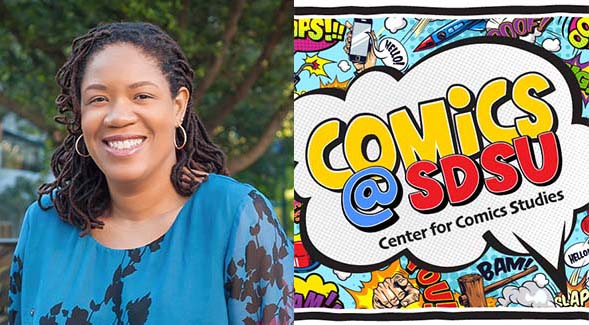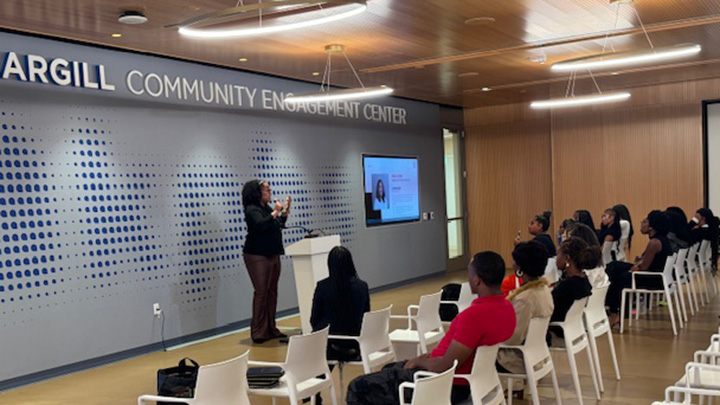Anti-Racism in the 50's: The Message of EC Comics
Qiana Whitted, a professor in the Department of English Language and Literature at the University of South Carolina, will be a guest lecturer at SDSU Feb. 7.

In the first half of the 1950s, EC Comics was known primarily for the ghastly stories of such 10-cent publications as “Tales From the Crypt” and “The Vault of Horror,” where severed limbs and decaying bodies were regular cover features.
But as University of South Carolina scholar Qiana Whitted writes in her book, “EC Comics: Race, Shock, and Social Protest,” the publisher also stood out for tackling issues of racism, equal protection and due process that were far ahead of their time. In one famed story, “The Whipping,” a white man incensed by his daughter’s relationship with a Mexican-American organizes a lynch mob that mistakenly murders the daughter instead.
Whitted will visit San Diego State University next week for “Captions and Corpses: How to Read an EC Comic,” a lecture sponsored by the Center for Comics Studies at the College of Arts and Letters and the National Endowment for the Humanities. Her talk is scheduled for 3-4:30 p.m. Feb. 7 at Gold Auditorium in the Donald P. Shiley BioScience Center; it is free and open to the public.
SDSU NewsCenter’s Jeff Ristine spoke to Whitted via Zoom about the impact of EC Comics and its relevance today. (Interview has been edited for length and clarity.)
What was EC trying to accomplish with these socially conscious stories that took on issues of race? What was their objective?
EC Comics was well known for horror, science fiction and crime comics, but after World War II, the publisher wanted to bring more explicit social messaging into these stories. The writers and artists worked to figure out a way to call people's attention to these pressing issues, racism, segregation, antisemitism, and so on, through the style and conventions of the comics they were already producing. Profit was always most important – at the end of the day, they wanted to sell comics. But the editors also thought about the young kids who were picking up their comics, many of whom were predominantly young white adolescent boys, and how these messages could reach that audience most effectively.
Do you think they did? Were the kids picking up on the messages of the “preachies,” as they were called?
The publisher, Bill Gaines, certainly did. He believed that he had developed an audience that knew how to interpret their comics. His stories offer certain signals to their readers, and when it came to the “preachies,” the creators included special cues to get that point across as well. The order in which the story appeared in the comic, or the focus on more realistic stories made a difference. Adult characters were often looked upon with suspicion. And that's one of the things that I will talk about when I come (to SDSU).
Although the “preachies” weren't broadcast on the comic book covers, they were the stories that were the most talked about in the letter pages. You find issue after issue of people coming back to stories like “The Guilty!” (an innocent Black man is confronted by a mob and shot for a murder actually committed by a white man) or “The Whipping” and you see multiple opinions in the letters, mostly folks who are in support of the stories and appreciate the messages and occasionally some who disagree. And so for me, I think, seeing how that conversation unfolded outside of the comics is another important way to gauge how the audience reacted.
In 1954 the shows on TV were “I Love Lucy” and “Father Knows Best.” What made stories like “The Whipping” relevant?
It's because of shows like “I Love Lucy,” that conveyed a particular view of American life that EC Comics made an impact. The creators wanted to get behind the scenes. They felt that they were holding a mirror up to a particular kind of 1950s suburban, predominantly white Christian way of life, and asked their readers, what are you not seeing? How can we present this to you in a different way, a more shocking and gruesome way, to get you to see the people and the struggles that you've ignored in the past?
Many of these stories take place in unnamed suburbs like in “The Whipping,” where the murder plot is spurred on by the idea of a brown person moving into a white neighborhood. Another story called “In Gratitude” follows a returning Korean War soldier who is upset that the Black man who saved him couldn’t be buried in a cemetery that was for “whites only.”
And EC Comics wound up getting hauled before Congress.
Teenagers had an unprecedented access to buying things on their own during this era and comics are cheap; they're just a dime, easily shared, and hidden very well. As EC continued to make money by shocking people into unexpected endings and illustrating creatures that they had never seen in comics before, parents, teachers and librarians were becoming more and more concerned. So in this era of “I Love Lucy” and McCarthyism too, it's no surprise that the U.S. Senate would take an interest in the question of how comics contributed to juvenile delinquency.
The transcript of those Senate Hearings is really fascinating, with senators trying to close-read and analyze comic books, while the publishers are pushing back by saying, “You know that's not how our readers look at these stories.”
Here we are 70 years later: Treyvon Martin, George Floyd and Kyle Rittenhouse. What is the EC Comics of today that is putting out messages?
I feel like there are a number of ways that contemporary comics are taking the EC approach. There are EC readers who are now older creators themselves, and they may aim for shock and for the over-the-top representations of violence or language, or sexuality. But when it comes to these social messages, one of the things that I point readers to is the fact that creators of color did not have the same kind of access that EC writers and artists were given to tell their own stories, and we're seeing more of that now.
So it's likely that something that would be considered a preachy back then is now being conveyed through a series like “Bitter Root,” which is from Image Comics. It takes place in the 20s and is created by three African- American writers and artists. It uses steampunk fantasy and historical fiction to tell a story about racism.
We also see the legacy of the “preachies” in biographical comics and graphic memoirs that are coming out now. John Lewis's “March” trilogy for instance, (and) George Takei’s “They Called Us Enemy.” The historical graphic novels are becoming another way to convey those messages in a style that can still keep readers engaged.



